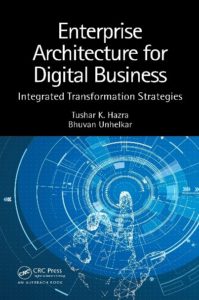
Over the past three or so decades, enterprise architecture or EA has established itself as a discipline in almost all enterprises – large and small. Starting with the early work by John Zachman [1], and with the maturing TOGAF standards [2], EA frameworks have been embraced consistently within many organizations. The need for and usage of these EA frameworks have grown over time, as they help organizations handle complexities and diversity, as well as mitigate the associated risks of shifting computing paradigms. 
The Enterprisers Project defines digital transformation [DT] as “the integration of digital technology into all areas of a business, fundamentally changing how you operate and deliver value to customers. It’s also a cultural change that requires organizations to continually challenge the status quo, experiment, and get comfortable with failure” [3].
In most modern enterprises, DT is an ongoing — and perhaps unending — journey. Continuous technological changes result in continuous transformation that in turn result in “Agile” or flexible enterprises. Hence, DT requires a well-orchestrated, innovative, and collaborative approach from the EA perspective. Conceptually, it may sound easy enough to achieve but in reality, it is a difficult task to accomplish. Many businesses struggle with how to transform efficiently and cost effectively. Organizations undergoing DT have to avoid the trap of either being too canonical, such that the transformation’s architecture starts with a solid theoretical foundation but becomes an implementation nightmare or starting the transformation in an ad-hoc manner, leading to skyrocketing costs and a lack of time for formal design. Both these options result in a negative economic impact to the business and severe dissatisfaction for customers. Primary objectives of DT are to improve customer or user engagement, deliver superior customer or user experience, generate new revenue streams, and enhance employee performance and overall operational efficiency of the business.
This book, based on extensive work experience of two authors, Tushar Hazra and Bhuvan Unhelkar, offers an integrated transformation approach that capitalizes on the EA of any organization. Instead of limiting EA to its contemporary technical dimension, this book integrates the technologies, business, frameworks, people, quality, and governance of the organization in order to create a future-ready business. Thus, this book further dives into the techno-business aspects of Big Data, Mobile, and Cloud that form the basis for digital business transformation strategies. This book has three parts:
- Setting the Context for Digital Business – presents an overview of the digital business and how it can harness the power of enterprise architecture
- The Digital Enterprise Architecture Life Cycle – elaborates various aspects of enterprise architecture life cycle in the context of digital transformation and emerging technology trends
- Leveraging the Value of Digital Enterprise Architecture – discusses how digital enterprise architecture can empower current and future digital transformation initiatives
In this book, the authors provide practical hands-on advice to professionals on digital transformations, especially in globally dispersed medium to large organizations. Furthermore, consulting companies and individuals will also find this a valuable addition to their bookshelf in terms of practical insights and guidance that the authors have gleaned as practitioners. Additionally, the case studies in the Appendix of this book are based on practical experiences from the trenches and, as such, provide a useful, real world angle to the topic of EA for future digital businesses.
In order to move forward with the DT journeys in this new horizon of post-pandemic era, practitioners must consider a broader perspective of EA. They must review the impacts as well as synergies of innovation, disruption, and collaboration with their transformation initiatives. An innovation is not just a new way of developing and deploying business solutions – it is also to deliver tangible business outcomes to customers proactively and consistently. Disruption often leverages innovation to accentuate the changes in a business using emerging technology trends. Collaboration harnesses the power of innovation and disruption to enable practitioners work together and achieve quantifiable business results. It is evident that in this near-post-pandemic era, a new horizon of the business world is evolving. The practitioners must endure rapid changes through the use of digital transformation while leveraging a nimble, flexible, and agile enterprise architecture framework that embraces the essence of innovation, disruption, and collaboration efficiently. Furthermore, while exploring the use of existing EA frameworks, a set of questions arise:
- How useful are these frameworks today in current era of digital transformation?
- Can these frameworks help EA as a discipline support an enterprise to address the disruption? If so, how flexible are these frameworks?
- And how easy or difficult are these frameworks to use in disruptive digital transformation initiatives?
Based on recent engagements from the trenches, it is clear that a holistic and pragmatic approach must comprise four essential stages:
- Strategize – during this stage, enterprise architecture practitioners or enterprise architects must support the corporate Board members, C-suite executives, and potential executive sponsors with creating the DT strategy for their enterprise, and subsequently influencing the formalization the strategy, and facilitating as well as cultivating envisioning prospective path forward for the entire organization. A DT strategy requires understanding current value streams, customer experience, and operational challenges while fostering the corporate business goals and objectives as well as revenue targets.
- Organize – the essence of this stage is to promote the concepts of reuse and replication while embracing the methodologies such as Agile, DevOps, or DevSecOps in the work environment. Since work from home (WFH) is a new normal, organizing the DT is vital to achieving the goals of the transformation successfully. Enterprise architects must help shaping the path forward with visual architectural models and empowering the teams involved in performing DT tasks, whether it involves pure-play application development or development of a digital platform.
- Orchestrate – while the previous stages ready an organization and prepare it with digital literacy, orchestrating the relevant activities to coordinate and execute prioritized efforts is of utmost importance for the enterprises. It helps them avoid potential risks, challenges, and issues associated with the life cycle of the DT journey. Hence, enterprise architects must leverage a comprehensive yet holistic architectural framework while taking an active role in operationalizing the DT efforts. This stage presents a crucial step for the enterprise architects to influence the involved teams, engage digital leaders and business stakeholders, train the teams and individuals to embrace the architecture mindset in conjunction with Agile, DevOps or DevSecOps methodologies. A combination of them will prove to be a highly effective and powerful orchestra for going digital and achieving success for digital transformation.
- Institutionalize – this stage presents an opportunity to leverage the lessons learned from previous stages and helps the enterprise architects to collect and cultivate the best practices and instill the effective principle, policies, and guidelines while enforcing compliance, risk mitigation, and governance procedures across the entire enterprise. During a typical DT life cycle, this stage can start in parallel with any of the above-mentioned stages and integrate seamlessly with activities enterprise architects get involved with the rest of the enterprise, whether to support agile application development, infrastructure refresh or modernization, or cloud migration initiatives.
These stages leverage a holistic EA framework that focuses on exploring who, why, what, when, where, and how questions throughout the DT life cycle. This framework can yield the most desirable outcomes in the post-pandemic new horizon while supporting an agile, and composable digital architecture that can sustain the transformation of an enterprise over the foreseeable future. This EA framework utilizes the basic tenets of Zachmann, TODAF, FEAF, and Gartner EA frameworks existing in most enterprises today – and do not require any additional investment in terms of training or learning. Furthermore, it allows the enterprise architecture to be more involved with the business domains to facilitate strategy planning and customer relationship building.
- Zachmann, John A. “A Framework for Information Systems Architecture.” IBM Systems Journal, Vol. 26, No. 3, 1987.
- TOGAF — The Open Group Architecture Framework (opengroup.org/togaf).
- The Enterprisers Project, https://enterprisersproject.com/what-is-digital-transformation
- Hazra, Tushar K., Unhelkar, Bhuvan, Leveraging EA to Incorporate Emerging Technology Trends for Digital Transformation, Cutter IT Journal, February 2016.
